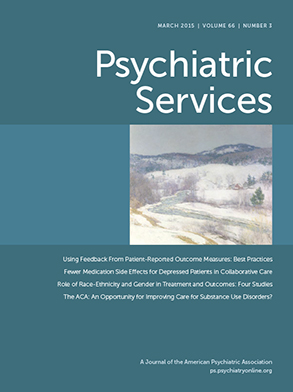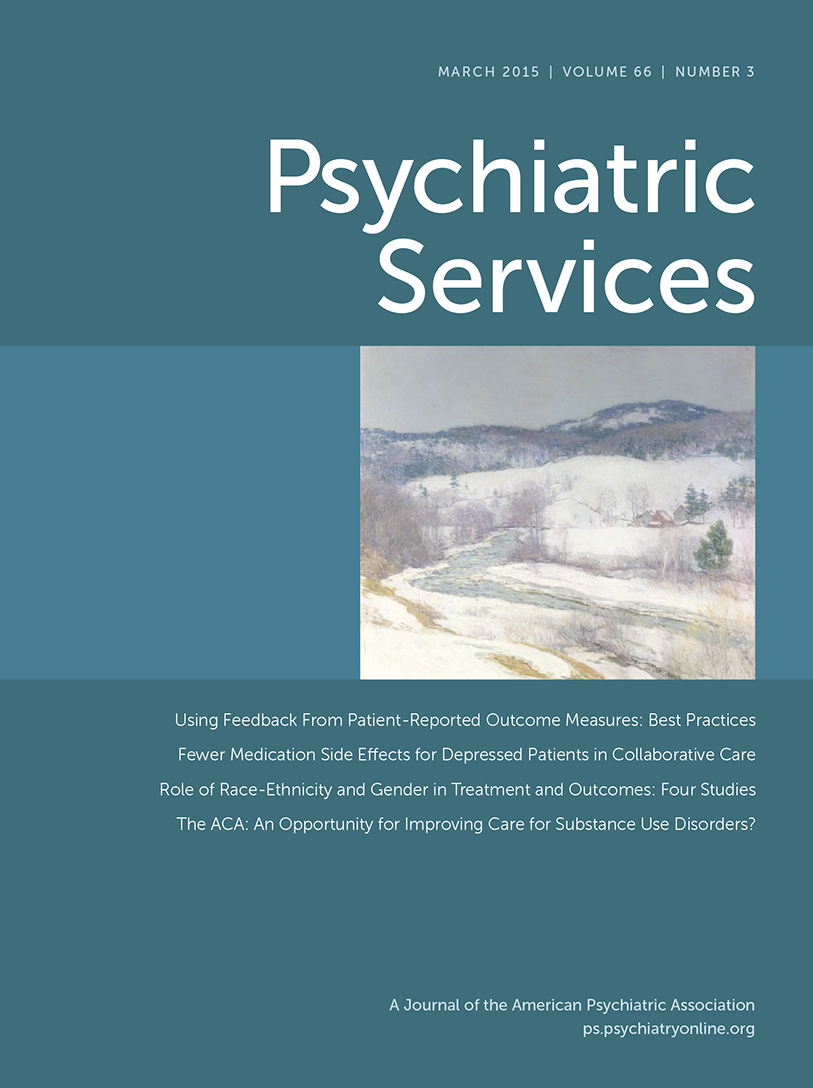The Patient Protection and Affordable Care Act (ACA) represents the most ambitious expansion and regulatory overhaul of the U.S. health care system since the introduction of Medicare and Medicaid. Although the principal goal of the law is to increase insurance coverage, the ACA also includes multiple reforms aimed at improving quality of care by holding clinicians and treatment programs financially accountable for providing high-quality services (
1). For example, the ACA provides for the development of new performance measures for primary care and chronic diseases and establishes an Interagency Working Group on Healthcare Quality to coordinate quality-related activities across 24 federal departments and agencies (
2). This Open Forum examines current use of quality measures for substance use disorder treatment and makes recommendations for development of more effective measures.
A Need for Investment in Quality Measures
The success of reforms to improve quality of health care depends on the availability of reliable, valid, and feasible quality measures. Quality measures indicate the capacity of a system to deliver care, the proportion of patients who are able to access and receive recommended care, and the outcomes of such care. These measures are used to assess the performance of a provider and a system and provide essential information for identifying areas of improvement and monitoring changes in the quality of care delivered. Quality measurement plays an important role in identifying and tracking progress toward organizational goals, identifying problems and opportunities for improvement, and comparing performance against both internal and external standards. Within the ACA, measurement is an essential component of several strategies to improve performance (
3,
4), including creating and implementing innovative payment and delivery models, value-based purchasing, and public reporting mechanisms so consumers and purchasers can make informed decisions when selecting health care providers and insurers (
1).
The ACA will also bring about significant changes in coverage for publicly funded substance use disorder treatment services, both in primary care and specialty care settings (
5,
6). The full implementation of the law will significantly expand the Medicaid population, making more individuals eligible for substance use evaluation and treatment if there is sufficient capacity. States that participate in the Medicaid expansion must provide benchmark and benchmark-equivalent plans to the newly enrolled population, and these plans will include coverage for substance use disorder treatment. Plans that are offered through the health insurance marketplace are required to cover substance use disorders at parity with medical and surgical benefits, owing to an expansion of the Mental Health Parity and Addiction Equity Act of 2008. Screening, brief intervention, and referral to treatment (SBIRT) for risky alcohol use will be a covered benefit in most states, and medical providers will be offered training in this modality. Persons with chronic substance use disorders will be eligible to receive care through “health homes,” which will integrate and coordinate all primary, acute, behavioral health, and long-term care (
7).
Despite this focus on quality measurement and increased coverage, currently the ACA directs little attention to the development and validation of quality measures for substance use disorders. For example, the ACA includes a core list of measures for evaluating Medicaid treatment, but only one is directly related to substance use disorder treatment (
8). This omission runs the risk of increasing coverage for substance use treatment without ensuring that the treatment is of high quality and of increasing potential access without ensuring that there is sufficient capacity to meet the additional need. Therefore, to realize the potential benefits of increased coverage for substance use disorders, it is necessary to develop, validate, and implement quality measures related to treatment of these disorders.
The ACA’s limited attention to the quality of substance use treatment is not unique. Over the past decade, the development and implementation of quality measurement have expanded, but apart from efforts by the Washington Circle (
www.washingtoncircle.org), few national efforts have included measurement activities related to substance use disorders. Excluding tobacco-related measures, only five of the 651 measures endorsed by the National Quality Forum (NQF) are related to substance use disorders. Similarly, the National Center for Quality Assurance (NCQA) has endorsed only two measures related to substance use. The measures endorsed by NQF and NCQA focus on substance use treatment initiation, substance use treatment engagement (NQF only), screening for substance use problems (NQF only), receipt of counseling (NQF only), patient experience with care (NQF only), and receipt of substance use treatment in different settings (NCQA only).
Notably, none of the endorsed measures has been found to have a strong relationship with clinical outcomes. For example, the treatment initiation and engagement measures, originally developed by the Washington Circle, have shown only a modest association with clinical outcomes (
9,
10). In addition, the substance use measures endorsed by NCQA and NQF focus only on limited aspects of the process of care. In point of fact, quality measures should and can cover the entire continuum of care—including prevention, screening, assessment, treatment, and continuing care—and include different types of measures—for example, the availability of resources at the system or organizational level necessary to deliver recommended care, process of care, outcomes of care, and patient experience. Despite the existence of effective pharmacotherapy and psychotherapies, no endorsed measures assess whether a patient received an evidence-based treatment or showed an improvement in outcomes, although several measures related to pharmacotherapy for alcohol use disorders are in development (
11). There are no measures of the physical or organizational infrastructure necessary to improve or sustain access and quality or of workforce capacity. Thus the available substance use treatment measures are small in number and limited in scope and do not reflect current knowledge of treatment effectiveness.
Challenges and Recommendations
There are many challenges to developing performance measures for substance use disorders (
12). Capacity is an important determinant of how well a system performs, but it’s unclear how capacity influences outcomes or which elements of capacity are most important. Many commonly used treatments have not been prospectively linked to outcomes, and there are major gaps in understanding what constitutes an evidence-based approach to prevention, screening, assessment and continuing care. Because substance use disorders affect many aspects of a person’s life and because treatment is often provided outside the general medical system, documenting and measuring care coordination and referrals will be challenging, in part because specific confidentiality requirements make it difficult for providers to share information (
13). When assessing the delivery of psychotherapy for substance use disorders, it is essential to move beyond simply counting the number of services provided and also assess whether providers document using techniques associated with an evidence-based psychotherapy. Finally, apart from toxicology screens, there are few objective outcome measures, and routine assessment of standardized self-reported outcomes is not widely used.
Furthermore, once quality measures are available, there are specific difficulties associated with implementing them. Stigma may prevent both patients and providers from identifying problematic substance use. There is no diagnosis code for risky drinking—drinking that puts one at risk of adverse consequences—the most prevalent condition related to substance use and the one primary care providers are most likely to encounter. The lack of universal screening means that detection and treatment are fragmented and inconsistent across primary and specialty care settings. Several available measures use the number of patients with positive alcohol screens to identify the size of the population to which the indicator applies, which has been shown to bias measurement and interpretation (
14). In primary care settings, the number of patients identified through screening is relatively small (
15). Given that providers are already required to measure many care processes, the addition of measures of less prevalent conditions may not be feasible. Practices for assessment and treatment of substance use disorders are not yet standardized and classified for use in administrative data sets. The Health Information Technology for Economic and Clinical Health Act bars facilities for treatment of substance use disorders from obtaining resources to acquire and implement health information technology; in general, behavioral health care providers lag behind primary care providers in implementing and using electronic health records. Eligibility criteria for treatment (including off-label use of medications) may vary across systems of care, making comparisons problematic.
Numerous studies suggest that most individuals with substance use disorders do not receive any treatment (
16)—and when they do receive treatment, it is not evidence based (
17). For patients, families, and society to benefit from the increased access to treatment for substance use disorders provided by the ACA, new measures must be developed and tested, while existing measures are refined. We need to develop measures of treatment capacity and availability and study how capacity influences performance and outcomes. The predictive validity of different care processes at the level of the individual as well as the program or organization (
18) needs to be established; this should be done by conducting prospective observational studies as well as effectiveness and implementation research rather than relying purely on data from efficacy studies. Data elements within the electronic health record should be standardized, and treatment guidelines for substance use disorders should be updated as new evidence emerges. New measures of quality should reflect the growth in knowledge about treatment effectiveness. We need to develop a methodology to test the validity of measures of treatment effectiveness when ethical reasons preclude using a randomized study design and agree upon what level of evidence is sufficient.
If performance measurement is to be feasible, we need to improve our ability to use data to populate measures and to interpret the data we have. Recent advances in natural language processing have helped to make abstracting electronic health records easier, and structured templates to facilitate documentation in the electronic health record may also be helpful. Clinical registries that systematize data collection, data extraction, and patient care could also be useful. Although there is an ICD-10 code for harmful alcohol use—in other words, use that is already causing damage to health—we should consider establishing a code for risky drinking, use at a level that confers a risk of harmful consequences. Establishing this code would allow providers to be reimbursed for ongoing counseling if the initial brief intervention at the time of identification of risk was unsuccessful.
Acknowledgments
This research was supported by a grant from the National Institute on Alcohol Abuse and Alcoholism. The authors acknowledge the helpful comments of Daniel Kivlahan, Ph.D., and Harold Alan Pincus, M.D., on an earlier version of this article.
The authors report no financial relationships with commercial interests.

